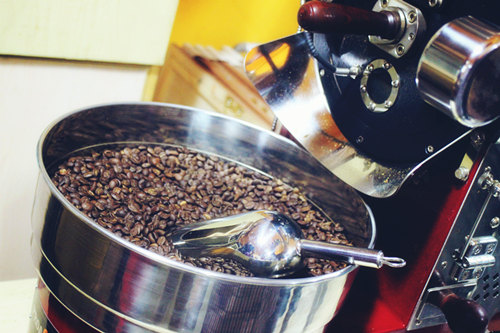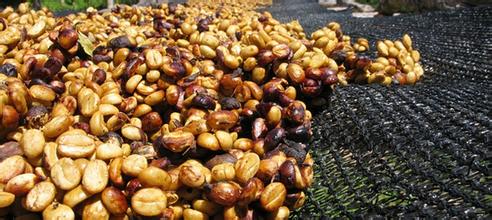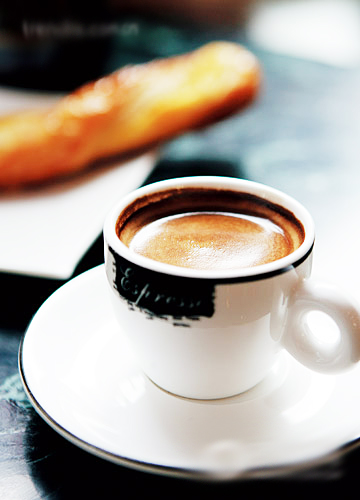Coffee technology: introduction to the type classification and characteristics of coffee roasting degree
There are three common types of roaster, namely, hot air type, direct fire type, and semi-direct fire semi-hot air type. Next, I would like to introduce to you the characteristics of the three models.
1. Hot air type:
The hot air roaster uses the blower to suck in the air, raises the temperature of the air through a heating coil, and uses hot air as the heating source to bake coffee beans. hot air can not only provide the temperature needed for baking. you can also use the power of airflow to stir coffee beans and kill two birds with one stone. Now there is a professional hot air roaster on the market, which combines the electric tumbling baking chamber with heat flow to make the coffee beans heated more evenly.
Advantages: high thermal efficiency, fast heating, relatively uniform heating of raw beans, easy to control.
Disadvantages: because the heating efficiency is high, it is easy to lead to excessive heating, resulting in the bean raw "core" is the so-called entrainment, and the temperature rise is too high, it is easy to make the coffee caramelization reaction is not enough!
The characteristics of the taste: the acidity is obvious, the taste is relatively clean and simple, but the taste is not rich enough and lacks depth, and deep baking is easy to produce pungent smell!
two。 Direct fire:
As the name implies, direct fire is the use of flame to directly heat coffee beans. Up to now, direct fire includes infrared ray and electric heating pipe in addition to general flame (including gas stove fire and charcoal fire).
Advantages: the baking time is long, which makes the caramelization reaction more sufficient and the flavor more rich.
Disadvantages: it is easy to cause uneven baking, and if the heat is not well controlled, it is also easy to scorch coffee beans and form a scorched bitter taste.
Taste characteristics: sweet, bitter and sour flavor is deeper than hot air, mellow, smooth taste, but the dry aroma of coffee beans is weak, sometimes when the roast is light, the taste of coffee beans will produce a strong smell of grass!
3. Semi-direct fire and semi-hot air:
The baking method which combines the advantages of direct fire type and hot air type is the mainstream of commercial coffee machine at present. Semi-direct-fire semi-hot air baking is actually similar to direct-fire baking, but because there are no holes in the outer wall of the baking container, the flame will not directly touch the coffee beans. In addition, ventilation and exhaust equipment should be added to introduce the hot air outside the baking container into the baking room to improve baking efficiency. Another function of this ventilation equipment is to suck out the silver skin of coffee beans. Avoid burning in the baking room due to high temperature to affect the taste of coffee beans.
This kind of roaster has the advantages and disadvantages of both hot air type and direct fire type, and its heating mode is changed by adjusting the speed of hot air and baking chamber. The bigger the hot air is, the faster the speed is, the closer it is to the hot air type, on the contrary, it is close to the direct fire type.
Taste characteristics: the overall coffee bean taste is relatively rich, mellow, dry and wet fragrance is distant, excellent performance on the characteristics of coffee producing area!

Source:
Happy Coffee Xiao Xu's blog
Important Notice :
前街咖啡 FrontStreet Coffee has moved to new addredd:
FrontStreet Coffee Address: 315,Donghua East Road,GuangZhou
Tel:020 38364473
- Prev

Coffee Technology: Misael Sauceda Honey treatment at Nicaragua Manor, Nicaragua
The planting conditions in Nicaragua are not inferior to those in Central American countries. Shaded coffee is grown at high altitudes. It tastes round and balanced with less sharp acid. The main unknown factor is war and hurricanes, which make a single farm unsustainable. There is no historical data for raw bean merchants to track and check farm data until after 2003, the bad factors of coffee quality are removed and backward intercourse.
- Next

The course of Italian Coffee: a detailed description of the extraction flavor of Italian concentrated Espresso
Espresso is often the cheapest coffee on MENU, which is really suitable for those who want to order but still want to save money. if you can correctly understand some knowledge of espresso, espresso will become the most professional, tasteful and inexpensive choice, even if it is not the best choice. The taste of Italian concentrated bitter coffee can be divided into four categories: sweet, sour, bitter and astringent
Related
- What is the meaning of lactic acid fermentation with coffee bean treatment?
- How to judge the state of foam by sound?
- How does the latte pull out the unicorn pattern? Come to get for a little trick to improve the flower pull!
- Will flower pulling affect the taste of the latte?
- Do you know the history of coffee?
- The difference between honey treatment and sun washing what is raisin honey treatment?
- What kind of milk can a novice use to make coffee foam to keep the foam longer? The correct method and skills of milking tutorial sharing
- Why do washed coffee beans taste sour? Flavor characteristics of washed Coffee
- Introduction to the skill of how to practice the size and height of water injection around the circle of hand-brewed coffee
- How do beginners practice coffee flower drawing from scratch?

